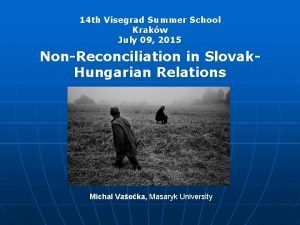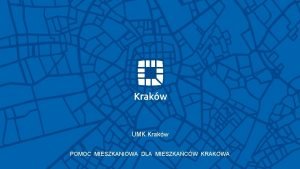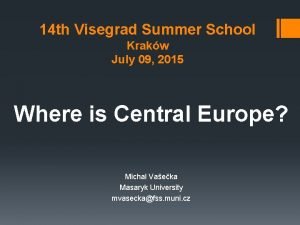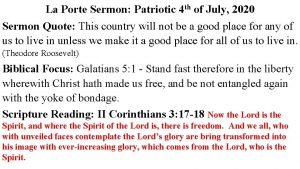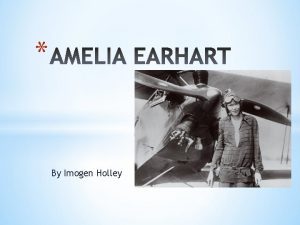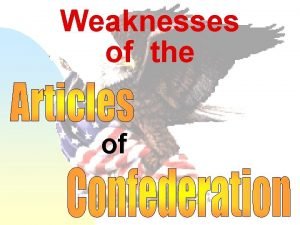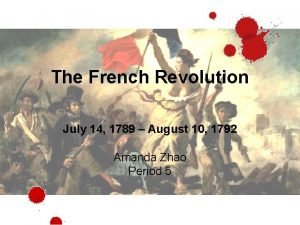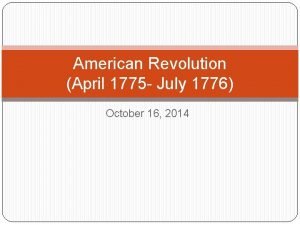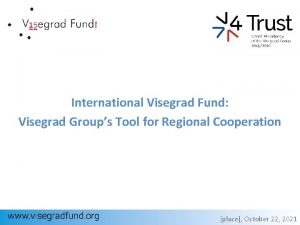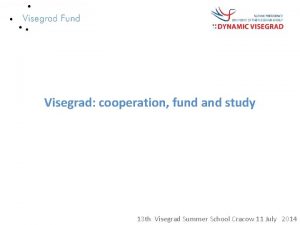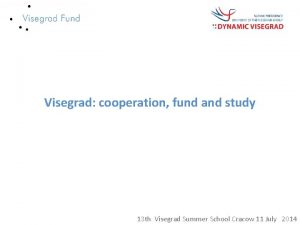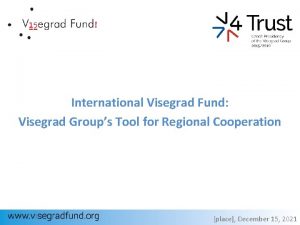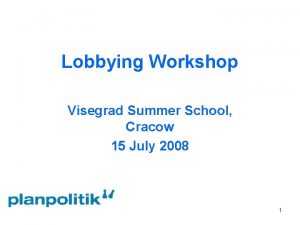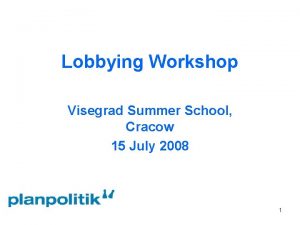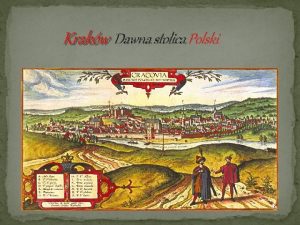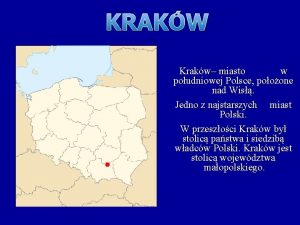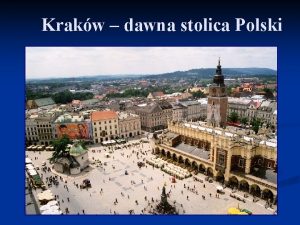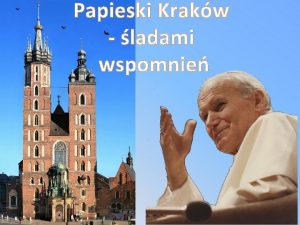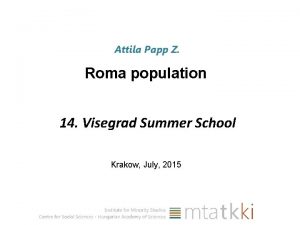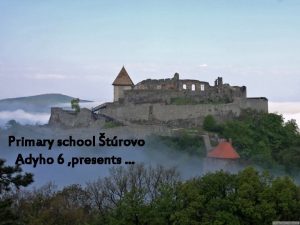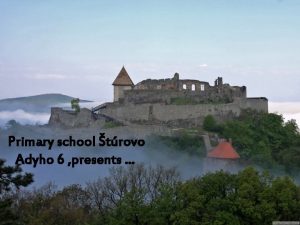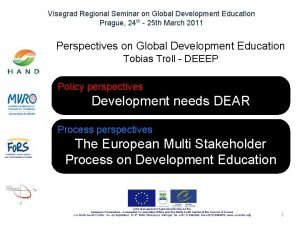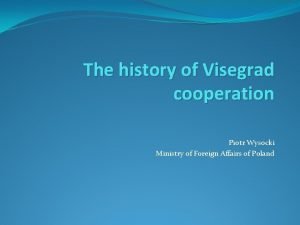14 th Visegrad Summer School Krakw July 09








































- Slides: 40

14 th Visegrad Summer School Kraków July 09, 2015 Where is Central Europe? Michal Vašečka Masaryk University mvasecka@fss. muni. cz

V 4 as embodiment of Central Europe? § Visegrád Congress /1335/ attended by John of Luxembourg, King of Bohemia, Charles Robert, King of Hungary, and Casimir III, King of Poland. § Visegrád meeting /1991/ attended by the President of Czechoslovakia, Václav Havel, the President of Poland, Lech Wałęsa, and the Prime Minister of the Republic of Hungary, József Antall.

Central Europe? How to define it? § 1. Cultural definitions (? ) § 2. Space of cultural trauma /Kundera/ (? ) § 3. Zwischeneuropa (? ) § 4. Mittleuropa (? ) § 5. Bloodlands (? ) § 6. Small ethno-linguistic national states (? ) § 7. Region of great „brains“ (? ) § 8. Institutionalized Central Europe - V 4 (? ) § or…

Central Europe? How to define it?

Kundera´s rediscovering of Central Europe § Kidnapping of Central Europe: § „This is why the countries in Central Europe feel that the change in their destiny that occurred after 1945 is not merely a political catastrophe: it is also an attack on their civilization. The deep meaning of their resistance is the struggle to preserve their identity - or, to put it another way, to preserve their Westernness. “ § Reaction of the „West“: § „Europe hasn't noticed the disappearance of its cultural home because Europe no longer perceives its unity as a cultural unity. “ § Central Europe as Eastern Europe: § „By virtue of its political system, Central Europe is the East; by virtue of its cultural history, it is the West. But since Europe itself is in the process of losing its own cultural identity, it perceives nothing but a political régime in Central Europe. To put it another way - it sees only Eastern Europe within Central Europe. “

Realm of Central Europe § From Kundera´s „Return of Central Europe“ to building of common identity § Region of shared history and shared values § Region of specific modernization and specific historical roots of civic and political culture

Historical roots of civic and political culture § Unfinished Modernization ► discrepancy between structural and cultural dimension of modernity § Egalitarianism ► anti-intellectual tradition § State Paternalism ► anti-liberal sentiments § Lack of Trust ► weak civic and political participation

Europe as a social construct § Europe is a triumph of imagination over geography Europe as a subcontinent (or peninsula? ) of Asia or Euroasia

Central Europe as a social construct § Central Europe - fixation of mind within larger imagined entity § Liquid borders of Europe and consequently even more liquid borders of Central Europe § https: //www. youtube. com/watch? v=ia-l. ZA 47 XBE

Central Europe as a part of former „Soviet Block“ § Central Europe (Mittle. Europa) § Eastern Europe § Balkan countries § Russia § Central Asia § Caucasus countries § Hansa cities § Cities of Adriatic shore

Mitteleuropa §Mitteleuropa - Friedrich Naumann (1915): § Imaginative geopolitics - creation of political and economic union, under „natural“ domination of Germany and Austro-Hungarian empire § Enthusiasm: § Recreation of Holy Roman Empire § Dominant position of „Central Powers“ § Prevention of development of land bridge between British possessions in Africa and India

Mitteleuropa § German Mitteleuropa (by political and cultural criteria) covering Austria, Croatia, Czech republic, Germany, Hungary, Poland, Slovakia, Slovenia, the Baltic states and parts of Ukraine, Russia, Romania, Serbia, France and Italy.

Mitteleuropa §Concept of Mitteleuropa - what if? § The very model of ethnolinguistic nation-state might have been limited to some oddball cases in Western Europe, while Central Europe might have consisted of multilingual federal states or federations – and be under domination of Germany and German culture.

Conceptualisations of Central Europe §Jesuits: § Europa Occidentalis § (British isles, France, Malta, Greek-speaking orthodox territories, western minor Asia, Crete, Cyprus, and former Crusaders states) § Europa Centralis § (Norway, Sweden, Finland, Estonia, Latvia, Denmark, Netherlands, Holy Roman Empire, and Switzerland) § Europa Orientalis § Poland-Lithuania, Kingdom of Hungary, Ottoman Balkans § Hispania and Rome

Conceptualisations of Central Europe § School atlas of European history: Historical Geography of Europe (1882) § Central Europe identified with Western Roman Empire - Charlemagne´s realm, later to become France and Holy Roman Empire § After 1871 concept of Central Europe, centered on France and newly-founded German Empire, was extended to embrace all of Italy and Austria. Hungary. Switzerland, Belgium, Luxembourg, Netherlands, and Denmark were seen as part of Central Europe.

Conceptualisations of Central Europe § Philips´s Historical Atlas: Medieval and Modern (1927) § Divide between Central and Eastern Europe is difficult to grasp - but Central Europe progressively expands eastwards § Eastern Europe was identified with Russia and Ottoman Empire

Conceptualisations of Central Europe § Austro-German conceptualization of Central Europe § Großer historischer Weltatlas or Austro. Schweizerscher Mittelschulatlas: § Central Europe identifiable with Holy Roman Empire, the Habsburg´s realms, and Prussia - German Empire and Austria-Hungary.

Conceptualisations of Central Europe §Third Reich § Anschluss of Austria, incorporation of Czech lands, and division of Europe on the religious border between Western and Eastern Christianity made Third Reich onto a political embodiment of Central Europe. § Germany controlled almost all territories associated with Central Europe in its most extensive variant. § Population defined as ´racially inferior´ was to be ameliorated either by Germanization, expulsion, or extermination.

Conceptualisations of Central Europe §After the World War II § Central Europe was not to be found anywhere, Western and Eastern Europe were defined clearly. § No nuance or gradation of argument – black and white perspective.

Conceptualisations of Central Europe §Atlas of Central Europe (Andrew Rónai, 1945) § Atlas's base map focuses on the arch of the Carpathians and the Danubian basin and shifts Central Europe eastwards. § Placing historical Hungary in the very heart of Europe.

Conceptualisations of Central Europe §History of East Central Europe (UWP, 1974) § East Central Europe implies West Central Europe. § But - West Central Europe ceased to exit… § Intellectuals from „wrong side“ of the fence identified with Central Europe in order to differentiate themselves from the uniformity and homogeneity of the Soviet world.

Conceptualisations of Central Europe §Historical Atlas of Central Europe (P. R. Magocsi, 1993) § End of the intellectual Cold War division of Central Europe - Magocsi divided Europe into three vertical sections. §Köztes-Európa, 1763 -1993 (Pándi Lájos, 1997) § Monumental atlas of „Zwischeneuropa“.

Leaving Central Europe… § V 4 (1991) § CEFTA (1992) § European Union enlargement (2004) § Recent rise of nationalism in Central Europe - real tragedy of Central Europe § Bibó´s „The poverty of the small states of Eastern Europe – genuine Central European concept, going beyond German concept of Kleinstaaterei

Do we need Central Europe? § Kroutvor (1988): „A united Europe already existed in the past, it was the Central Europe, as embodied by the Austro-Hungarian monarchy - whatever our opinion may be of this defunct state. “ § Political cooperation - EU, military cooperation, diplomacy, common energy policies, etc. § Economic cooperation § Cultural cooperation

Divided we stand?

Divided we stand?

Divided we stand…

And the winner is…

Central Europe without Central Europeans? § V 4 functions, it embodies Central Europe - but just part of it, to identify it with its „core“ of it would highly problematic… § There is not a single polity with entirely natural borders… V 4 is a great concept, but it excludes others from „Central Europe“. § Culture of apple strudel is still here… But Central Europe is disappearing from imagination of „Central Europeans“… Do they need it? Or - is it purely an intellectual concept? § … More convinced Central Europeans now live on the shores of the Atlantic than in the region itself…

Constructing Central Europe? § People keep imagining and re-imagining Europe and Central Europe… § Central Europe and its unique experience lives and reproduces itself as a social construct within cinematography of particular Central European countries. § Central Europe has always been a fascinating crossroad of ideas and ideologies as well as the birthplace of wars and totalitarian systems. The search for Central European identity is by far the best portrayed in Central European films. They show moral dilemmas od individuals and nations of Central Europe and can explain exhaustion by Central Europe.

Central European Cinema The Shop on Main Street - Ján Kádar, Elmar Klos § Non-heroic "ordinary" man in the midst of the turmoil caused by the necessity of making crucial life-and-death decisions. Tragedy in the lives of human beings facing moral disintegration in the Slovak "puppet" Nazi state in WWII. § Oscar winner.

Central European Cinema Closely Watched Trains - Jiří Menzel § Tragicomic private problems of a young man working at a small Central Bohemian railway station in the course of WWII. Individual lives in the omnipresent war situation. Humor, love, sex, and death in a film based on a novel by the renowned Czech writer Bohumil Hrabal. § Oscar winner.

Central European Cinema Ashes and Diamonds - Andrzej Wajda § Film focuses on a small Polish town celebrating the end of the war while new animosities are arising. Passion and anger, visual dynamism that includes the heavy use of symbols. The metaphorical message of the film suggests that Polish identity was harmed not only by the fascist period, but also by the import of Communism from the Soviet Union, a daring statement in the 50 s.

Central European Cinema Mephisto - István Szabó § Based on a novel by Klaus Mann, a deeply disturbing film about the complicity of ordinary people under fascism. In early 1930 s Germany, the title character, an ambitious actor, takes a dangerous path. § Best Foreign Film 1982.

Central European Cinema The Tin Drum - Volker Schlondorff § Oscar award-winning adaptation of Nobel Prize winner Gunter Grass' allegorical novel depicting Oscar, the son of a German rural family living in 1925 in Danzig/ Gdańsk. The little boy decides "never grow up". This is a visionary work of art full of surreal, imagery, eroticism and fierce satire.

How do we see each other? Mutual Perceptions of the Visegrad Citizens Mutual Images § To what extent do you trust the nations living in V 4 countries (% of responses „definitely + somewhat trust“) Source: IVF 2003.

How do we see each other? Mutual Perceptions of the Visegrad Citizens Mutual Images § When thinking about the other nations do you perceive them as similar or different ? (% of very + somewhat similar) Source: IVF, 2003.

How do we see each other? Mutual Perceptions of the Visegrad Citizens § Evaluation of willingness to cooperate (% of responses „high“). Source: IVF 2003

How do we see each other? Mutual Perceptions of the Visegrad Citizens Contacts across the borders § „Have you visited any of other three V 4 countries since January 2002 (in last 1, 5 years) for business or private purposes? “ Source: IVF, 2003.

Visegrad in the EU – Common versus Individual Approach ? Identification of Regional Interests ? § “Should your country only defend its own interests in the European Union, or should it also take into account the interests of the Visegrad members? “ Source: IVF, 2003.
 Visegrad summer school
Visegrad summer school Krakw
Krakw Krakw
Krakw Pacto de visegrad
Pacto de visegrad Bosanski pravopis
Bosanski pravopis Lodi unified summer school
Lodi unified summer school Crescenta valley high school summer school
Crescenta valley high school summer school Haltom high school summer school
Haltom high school summer school Harris burdick archie smith boy wonder
Harris burdick archie smith boy wonder Harris burdick pictures missing in venice
Harris burdick pictures missing in venice July 1-4 1863
July 1-4 1863 Tender mean
Tender mean Ruth bruno
Ruth bruno 2001 july 15
2001 july 15 2003 july 17
2003 july 17 July 30 2009 nasa
July 30 2009 nasa Sources nso july frenchhowell neill technology...
Sources nso july frenchhowell neill technology... What is the significance of july 4 1776 brainpop
What is the significance of july 4 1776 brainpop Poppies in july aoifes notes
Poppies in july aoifes notes The cuban melodrama
The cuban melodrama Poppies in july
Poppies in july July 10 1856
July 10 1856 Ctdssmap payment schedule july 2021
Ctdssmap payment schedule july 2021 Sergei korolev
Sergei korolev 6th july 1988
6th july 1988 Monday 13th july
Monday 13th july On july 18 2001 a train carrying hazardous chemicals
On july 18 2001 a train carrying hazardous chemicals July 4 sermon
July 4 sermon June too soon july stand by
June too soon july stand by July 2 1937 amelia earhart
July 2 1937 amelia earhart June 22 to july 22
June 22 to july 22 July 12 1776
July 12 1776 Recognizing imagery
Recognizing imagery Super saturday tribal bingo july 4
Super saturday tribal bingo july 4 January february march april may june
January february march april may june July 14 1789
July 14 1789 Malaga in july
Malaga in july Why are leaf yeasts more plentiful in july
Why are leaf yeasts more plentiful in july July 26 1953
July 26 1953 July 16 1776
July 16 1776 Ivc summer classes for high school students
Ivc summer classes for high school students
